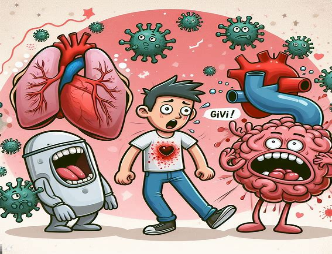By Neha Mathur, Jun 2023, The Lancet
In a recent study posted to Preprints with The Lancet* server, a team of researchers performed an extensive database search to identify studies providing consistent data on structural and functional alterations in organs and body parts innervated by the vagus nerve in subjects with post-coronavirus disease 2019 (COVID-19) condition (PCC), also known as long COVID.
The study aimed to research If vagus nerve dysfunction has a central pathogenic role in the pathophysiology of the post-COVID condition.
Background
PCC or long-COVID affects at least 5 to 10% of individuals who survive acute severe acute respiratory syndrome coronavirus 2 (SARS-CoV-2) infection. The vagus nerve innervates the main sites primarily affected by PPC, e.g., the pharynx, larynx, heart, lungs, and gastrointestinal (GI) tract.
Thus, it is likely that early, persistent alteration of the vagus nerve provides insight into several PCC symptoms, such as dysphagia, dyspnea, and dysautonomia. Understanding how the vagus nerve interacts with COVID-19 would enable a better understanding of PCC pathogenesis.
Eventually, this could help find more accurate diagnostics and treatments for PCC. However, there is still a lack of objective evidence of vagus nerve dysfunction in subjects with PCC is lacking.
About the study
In the present cross-sectional Vagus-COVID-19 study, researchers recruited age and gender-matched subjects with PCC, of which 30, 14, and 16 had symptoms suggesting vagus nerve dysfunction, acute COVID-19-recovered, and with no COVID-19 history, respectively. They compared their vagus nerve structure and functionality.
All study participants had at least one vagus nerve-related symptom, e.g., dysphonia, dysphagia, dyspnea, tachycardia, cough, orthostatic hypotension, GI tract perturbations, dizziness, or neurocognitive issues, from the WHO-specified list.
AI In Healthcare eBook Compilation of the top interviews, articles, and news in the last year.Download the latest edition
They identified these individuals from a prospective observational cohort of COVID-19 patients who contracted the disease between September 2021 and March 2022. The team collected demographic data, COVID-19 history, and a questionnaire enquiring 36 persistent PCC symptoms for each study group.
For morphological assessment of the vagus nerve, the team performed a neck and thoracic ultrasound of respiratory muscles. In functional assessments, they performed dysphonia, dysphagia, and dysautonomia tests. Other tests included maximum inspiratory pressure (MIP), heart rate variability (HRV), and sympathetic-reflex response (SRR).
They described continuous variables using standard deviation (SD) or interquartile range(IQR); categorical factors as percentages. Next, they compared quantitative variables using the Mann–Whitney test and used the Kruskal–Wallis test for comparisons across more than two groups. Finally, a chi-squared test compared estimated proportions.
Results
Of 341 participants with PCC, most were women with a pre-COVID-19 history of allergies. Also, 67% of participants had one or more vagus nerve-related symptoms, with more symptoms prevalent in individuals with PCC than in COVID-19-recovered and SARS-CoV-2 uninfected individuals, i.e., the other two study groups.
Four participants with PCC had alterations involving thickening and increased echogenicity of the perineurium, whereas two had focal thickening of the nerve, as assessed in neck ultrasound. In the thoracic ultrasound, 14\30 participants with PCC had flattened diaphragmatic curves.
Over 60% of subjects with PCC had a reduction in maximum inspiratory pressure, often associated with a significant decrease in diaphragm thickness and mobility, suggesting respiratory muscle weakness that could justify dyspnea, albeit lung imaging being normal.
The study evaluations demonstrated the organicity of the PCC. The frequent objective observations were altered dysphonia scales, reductions in MIP, and flattening of both hemidiaphragms, followed by reduced esophageal-gastric-intestinal peristalses and changed swallowing efficiency.
Similar changes occur during vagus nerve inflammation. Also, subjects with Guillain-Barré syndrome have structural changes in the vagus nerve and cervical spinal roots. Neural or perineural thickening observed in lateral neck ultrasound suggested SARS-CoV-2-induced direct and indirect nerve damage, i.e., neuroinflammatory response.
Studies have described diaphragm dysfunction with a significant reduction in contractility in survivors of severe COVID-19, similar to myopathy of post-intensive care syndromes. However, this study’s observations are not attributable to post-intensive care syndrome.
Also, this study did not report extensive information on the internal structure of the nerve or the perineurium, especially in post-SARS-CoV-2 infection ultrasounds. Also, this study’s vagus nerve ultrasound findings were in striking contrast with 11 subjects with PCC having a smaller cross-sectional area of both vagus nerves.
Conclusions
The study findings point to a crucial pathogenic role of vagus nerve dysfunction in the PCC pathophysiology.
It evidenced organic alterations along the vagus nerve in PCC patients. This data is highly informative for clinical evaluations of the PCC syndrome, to inform PCC-related cohort studies, and facilitate evaluating therapies to improve PCC-related dysautonomia.
Future studies should investigate whether vagus nerve ultrasound could fetch different findings in subjects with PCC during the early and late phases of the disease, which might affect its therapeutic interventions.
